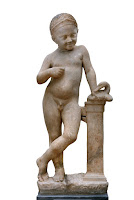 |
| Exhibition View (Photo: onassisusa.com) |
Yet
many of these lesser-known activities get plenty of excellent publicity, and
their sponsoring organizations work hard to get the word out. So I'm always
surprised to see how much many of us miss. I suppose it’s because there’s so
much on offer, and we just can’t keep up with all that’s available.
The
work of the Onassis Cultural Center in Olympic Tower, 645 Fifth Avenue (at 51st
Street) is a good example of what I’m describing. The excellence of the
programs and exhibitions at the center is noteworthy, and I think these events
are well attended, but somehow (through no fault of the center) many of us just
don't know about them and we tend to forget about watching for what's coming up
at the center.
The
current exhibition — the 17th, I've been told — opened to us on March 9, and
now, having just discovered it, I want to tell all my friends about it and give
you an idea of how impressed I was with what’s on at the Onassis Cultural
Center just now. The exhibition ends on June 24, so if you're a fan of ancient
Greek art, you want to take a look at A World of Emotions — Ancient
Greece, 700 BC - 200 AD. Make a point of getting over to the Olympic
Tower.
 |
| Boy with a Goose (Photo: National Archaeological Museum,Athens) |
The
idea behind the exhibition is to invite us, as visitors, to think about
the role of emotion in our lives. At the same time the exhibition provides an
opportunity to give attention to how all the many emotions we experience, “in
our interpersonal relations, in private life, in the public sphere, and in
religious worship” (as described in the exhibition’s very well-written guide)
penetrate everything we do and contribute totally to all art and literature. So
the exhibition gives us an opportunity to connect what we know and experience
about our own emotions with what we can now learn about their role in ancient
Greek life and behavior.
It’s
not possible to describe all of the beautiful objects on display in the
exhibition. Of course there are the sweet innocent pleasures, satisfying just
to look at (such as the famous Boy with a Goose, a third-century BC sculpture
from the National Archaeological Museum, Athens). Once I looked at it the other
day I immediately remembered how much I loved it when I saw it at the museum
back in — I think it was — 1981 or so). Equally thrilling are some of the
beautiful and often very moving depictions of funerary and commemorative
steles. Indeed, the descriptions of the role of cemeteries and death in the
lives of the ancient Greeks are touchingly described in the section on grief.
Naturally
much attention is given over to drama, the art so often performed for the
Greeks and comprising — as we all know — a big part of their life. One section
of the exhibition is titled “Enslaved by Emotions” and I really liked one
thesis put forward in this section: “The earliest and most emblematic text of
Greek literature, the Iliad (ca. 700 BC) has an emotion as its
subject: Achilles’ uncontrolled indignation, caused by an insult.” Immediately
following is a section — certainly linked to emotions that enslave —
about Medea. I was impressed by the description and visuals of (and
wished I had been able to witness) a 1984 Japanese all-male staging produced by
the Japanese director Yukio Ninagawa. And for opera lovers like me, it was real
trip down memory lane to see the commentary about Maria Callas (including a
fantastic oversize photograph of her in her perhaps-most-famous operative
role).
For
me the exhibition also provided the great pleasure of connecting some of what
I’ve experienced in my past with what is on display here, and I’m very
satisfied with what I’ve seen in A World of Emotions. As I think
about some of what I’ve learned in my own classical studies (although I am
definitely no expert or authority, I can assure you), I find with this
exhibition that I’m looking at wonderful depictions of many of the stories and
myths I grew up with and learned about as I was educated. And what I kept
hearing about and learning about throughout my adult life as I played with “the
classics.” Certainly one of my endeavors of a few years ago returned vividly to
mind as I viewed this exhibition, as many of the displayed items brought back
happy memories of a long journey throughout Greece in the 1980s. On that trip I
took along the fairly recent and much-lauded Robert Fitzgerald translation the Iliad and Odyssey.
For me, reading these made ancient Greece came alive, even more so than I had
experienced in previous trips. This exhibition helped me remember that time
with even more pleasure.
Exhibition
hours are Mon, Tue, Wed, Fri, and Sat: 10 AM - 6 PM (Thu from 10 AM - 9 PM).
Find time to visit Onassis Cultural Center before June 24.

No comments:
Post a Comment